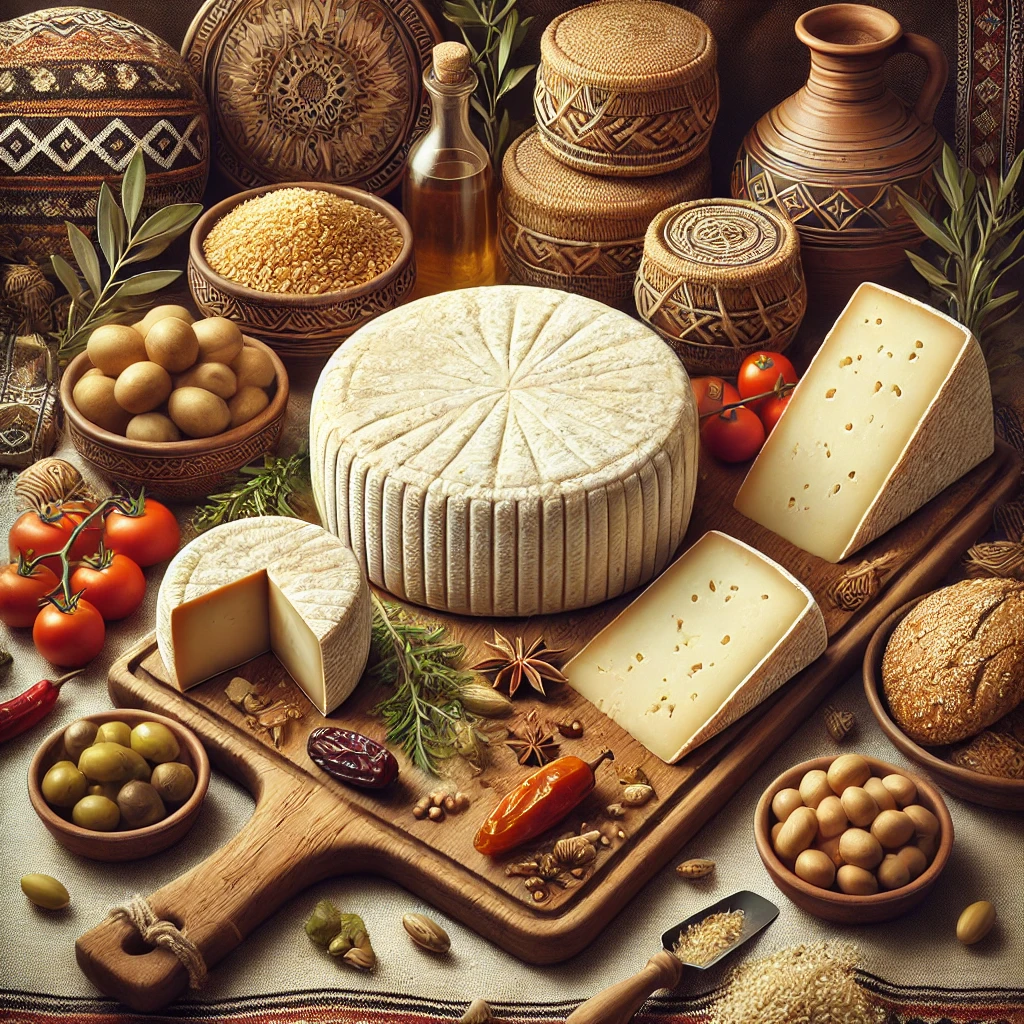North Africa’s culinary identity is shaped by deserts, mountains, pastoral traditions, and centuries of cultural exchange. Algeria, the largest country in Africa, is home to a rich yet often overlooked cheese heritage rooted in rural life and nomadic survival. Among these traditional dairy products, Tafraout cheese stands out as a rare and distinctive delicacy—deeply connected to local environments, Berber culture, and artisanal know-how.
Unlike standardized European cheeses, Tafraout cheese is rustic, regional, and largely undocumented outside its place of origin. It reflects the ingenuity of Algerian communities who transformed milk into a nourishing, preservable food using minimal tools and natural conditions. This comprehensive guide explores the origins, production, taste, uses, cultural value, storage, and future potential of Tafraout cheese.
🧀 What Is Tafraout Cheese?
Tafraout cheese is a traditional Algerian cheese, primarily produced in rural and mountainous regions where small-scale livestock farming dominates. It is typically made from goat’s or sheep’s milk, sometimes blended with cow’s milk, depending on availability.
Key Characteristics
| Feature | Description |
|---|---|
| Cheese type | Artisanal, semi-firm to firm |
| Milk | Goat, sheep, or mixed |
| Texture | Dense, slightly crumbly |
| Flavor | Tangy, earthy, lightly salty |
| Color | Pale ivory to yellowish |
| Aging | Short to moderate |
| Production | Small-batch, traditional |
Tafraout cheese is valued less for refinement and more for authenticity, nutrition, and resilience.
🌍 Origins and Cultural Context
Rooted in Rural Algeria
The name Tafraout is associated with Amazigh (Berber) regions and mountainous terrain, where herding goats and sheep has long been a way of life. In these areas:
-
milk is abundant during certain seasons
-
refrigeration was historically unavailable
-
preservation was essential
Cheese like Tafraout developed as a practical solution to store milk nutrients for later use.
Amazigh (Berber) Influence
Amazigh communities have preserved dairy traditions for centuries. Tafraout cheese reflects:
-
oral knowledge passed through generations
-
techniques adapted to climate and altitude
-
a strong connection between food and identity
Cheesemaking was often the responsibility of women, who controlled milk processing within households.
🥛 How Tafraout Cheese Is Made
Tafraout cheese does not follow a rigid recipe. Its production varies by village and family, but the general process remains consistent.
1. Milk Collection
Fresh milk is collected from:
-
goats (most common)
-
sheep
-
occasionally cows
Milk may be used raw or gently heated.
2. Coagulation
Curdling occurs through:
-
natural fermentation
-
traditional rennet
-
plant-based coagulants in some areas
This transforms milk into curds and whey.
3. Draining & Pressing
Curds are:
-
placed in cloths or woven baskets
-
pressed by hand or weighted stones
This removes excess whey and forms a compact cheese.
4. Salting
Salt is applied:
-
directly to the curd
-
or rubbed onto the surface
Salting improves flavor and shelf life.
5. Drying or Light Aging
The cheese may be:
-
air-dried in shaded areas
-
lightly aged for days or weeks
Some versions are lightly smoked, adding complexity.
🧂 Taste and Texture Profile
Flavor Characteristics
Tafraout cheese delivers a robust yet balanced taste:
-
tangy and lactic
-
earthy and slightly rustic
-
moderately salty
-
subtle herbal notes from animal diet
The flavor intensifies with age but rarely becomes overpowering.
Texture
-
firm but not hard
-
slightly crumbly when broken
-
becomes drier over time
-
sliceable when young
It is designed for durability rather than creaminess.
🍽️ Traditional Culinary Uses
Tafraout cheese is a staple ingredient rather than a standalone luxury.
1. Simple Table Cheese
Often eaten:
-
with flatbread
-
alongside olives
-
with tea
Its saltiness complements plain foods.
2. With Grains and Couscous
Small pieces are:
-
crumbled over couscous
-
eaten with barley or semolina dishes
The cheese adds protein and richness.
3. Cooked Dishes
In some regions, Tafraout cheese is:
-
added to vegetable stews
-
melted slightly into sauces
-
used as a filling for breads
4. Grilled or Heated
Firm versions can be:
-
grilled briefly
-
warmed over embers
They soften without fully melting.
🥂 Pairings: What Goes Well with Tafraout Cheese?
Food Pairings
| Pairing | Why It Works |
|---|---|
| Flatbread (khobz) | Neutral base |
| Couscous | Traditional balance |
| Olives | Shared saltiness |
| Honey | Sweet-salty contrast |
| Roasted vegetables | Earthy harmony |
Beverage Pairings
-
mint tea
-
black tea
-
fermented milk drinks
-
still water
Simple drinks allow the cheese’s natural flavor to shine.
🧊 Storage and Shelf Life
Tafraout cheese is designed for short- to medium-term storage.
Shelf Life
| Type | Duration |
|---|---|
| Fresh | 3–5 days |
| Lightly aged | 2–3 weeks |
| Dried or smoked | Up to 1 month |
Storage Tips
-
keep in a cool, dry place
-
wrap in breathable cloth
-
avoid sealed plastic
-
protect from humidity
🌍 Comparison with Other North African Cheeses
| Cheese | Country | Key Difference |
|---|---|---|
| Tafraout | Algeria | Semi-firm, rustic |
| Bouhezza | Algeria | Aged in goatskin |
| Rigouta | Tunisia | Fresh, soft |
| Jben | Morocco | Fresh, creamy |
| Wagashi | West Africa | Fresh, often fried |
Tafraout stands out for its balance between freshness and preservation.
🌱 Nutritional Value
Tafraout cheese is nutritionally dense and well-suited to pastoral diets.
Benefits
-
high protein content
-
rich in calcium
-
good fat profile (especially goat/sheep milk)
-
easily digestible for many people
It provided essential nutrients in regions with limited food variety.
🌍 Modern Relevance and Future Potential
Today, Tafraout cheese remains:
-
mostly unknown outside local markets
-
produced in small quantities
-
rarely exported
However, it has strong potential due to:
-
global interest in traditional foods
-
demand for artisanal cheeses
-
appreciation for North African cuisine
With proper documentation and protection, Tafraout cheese could become a recognized heritage product of Algeria.
⭐ Conclusion
Tafraout cheese from Algeria is a powerful reminder that some of the world’s most meaningful foods are born from necessity, tradition, and respect for nature. Rustic, nourishing, and deeply tied to Amazigh culture, this cheese tells a story of resilience and ingenuity.
While it may never rival industrial cheeses in scale, Tafraout’s value lies in its authenticity. For those seeking genuine flavors and cultural depth, it offers a rare and rewarding taste of North African heritage.
FAQs – Tafraout Cheese
1. What milk is used to make Tafraout cheese?
Mostly goat’s or sheep’s milk, sometimes mixed with cow’s milk.
2. Is Tafraout cheese aged?
Yes, but lightly. Aging usually lasts from a few days to a few weeks.
3. Does Tafraout cheese melt?
It softens when heated but does not melt like mozzarella.
4. Is Tafraout cheese salty?
Moderately. Salt is used mainly for preservation.
5. Where can Tafraout cheese be found?
Primarily in rural Algerian regions; it is rarely exported.



